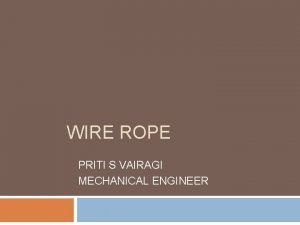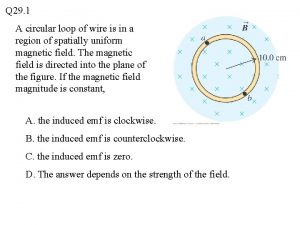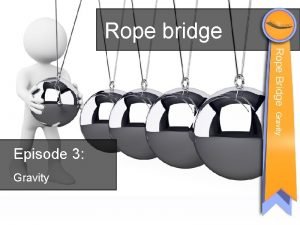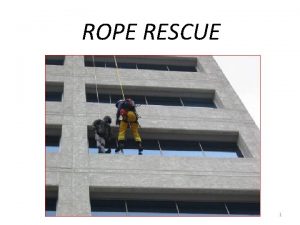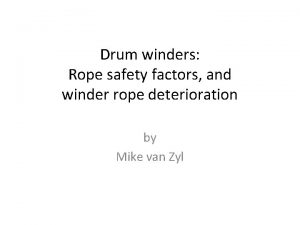WIRE ROPE PRITI S VAIRAGI MECHANICAL ENGINEER A











- Slides: 11

WIRE ROPE PRITI S VAIRAGI MECHANICAL ENGINEER

A hoisting device use chain, fibre or wire rope as its lifting medium. Wire rope consists of several strands laid (or ‘twisted’) together like a helix. Each strand is likewise made of metal wires laid together like a helix. Abrasion resistance increases with fewer, larger outside wires per strand fatigue resistance increase with more outside smaller wires per strand.

Advantage of wire rope over chain Steel wire ropes are extensively used in hoisting machinery as flexible lifting appliances. As compare to chains they have the following advantages: Lighter weight. Less susceptibility to damage from jerk. Silent operation even at high working speed. Greater reliability in operation

Wire rope are manufactured from steel wire with an ultimate strength of σ = 1600 to 2000 N/mm 2. In the process of manufacturing the wire is subjected to special heat treatment which, combined with cold drawing, imparts high mechanical properties to the wire

Ropes made from metal strands are called wire rope as shown in figure 12

Construction of wire rope : Material for steel wire ropes are generally high carbon steel. Most of the wire ropes are made up of IPS (improved plaw steel) with ultimate tensile strength (σut) of 2000 N/mm 2, Several other grades are also used, plaw steel (σut = 1600 N/mm 2) and mild plaw steel (σut = 1200 N/mm 2). Steel wires are manufactured by special machines. Initially separate wires are twisted to form the strands and strands are again twisted to form rope.

Designation of wire rope construction of ropes is indicated by two numbers, 6× 7, 6× 19, 6× 37 where 6 for No. of strands and 7, 19, 37 for No. of wires in each strands. More the number of wires in each strand, more the flexible the rope will be. If number of wire is less the rope is stiffer. 6× 7 : rope is made up of heavy wires and provides maximum resistance to wear and vibration. 6× 19 : good compromise between flexibility and wear. It is most popular and widely used. 6× 37 : Extra flexible are used where abrasion and wear are not very severe. Relatively sharp bends can be tolerated.

The constructions of wire rope are shown in Figure 13 (a) and (b). The wire rope consists of a number of strands, each strand comprising several steel wires. The number of wire in each strand is generally 7, 19 or 37, while the number of strands is usually six. The individual wires are first twisted into the strand then the strands are twisted around a fibre or steel core

Specification of wire rope The specifications of wire rope include two numbers, such as 6 x 7 or 6 x 19. The first number indicates the number of strand in the wire rope, while the second gives the number of steel wires in each strand. The central portion of the rope is called core. There are three types of cores-fibre, wire and synthetic materials. The fibre consists of natural fibre like sisal, hemp, jute or cotton. The fibre core is flexible and suitable for all conditions except when the rope is subjected to severe crushing.

The lay of the rope refers to the manner in which the wires are helically laid into strands and strand into the rope. If the wires in the strand are twisted in the same directions as the strands, then the rope is called a Lang’s lay rope. When the wire in the strand is twisted in directions opposite to that of strands, the rope is said to be regular–lay or ordinary-lay. There are mainly three types of ropes parallel, composite and crossed.

The lays of wire rope is shown in the fig. (a)parallel, (b)composite and (c)crossed.
 Priti albal
Priti albal Vallabh vidyanagar
Vallabh vidyanagar Cementoenamel junction
Cementoenamel junction Priti srinivas
Priti srinivas Priti rao infosys
Priti rao infosys Steel wire rope pc strand
Steel wire rope pc strand Loos seismic cables manufacturers
Loos seismic cables manufacturers Wire rope nomenclature
Wire rope nomenclature Wire rope nomenclature
Wire rope nomenclature Shead net
Shead net A flexible loop of wire lies in a uniform magnetic field
A flexible loop of wire lies in a uniform magnetic field A single wire wrap into a cylindrical wire coil is called
A single wire wrap into a cylindrical wire coil is called







